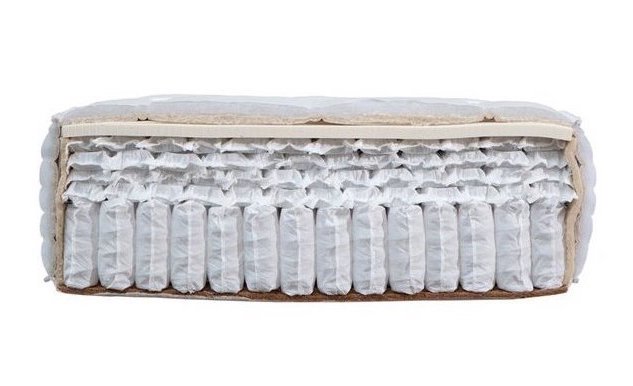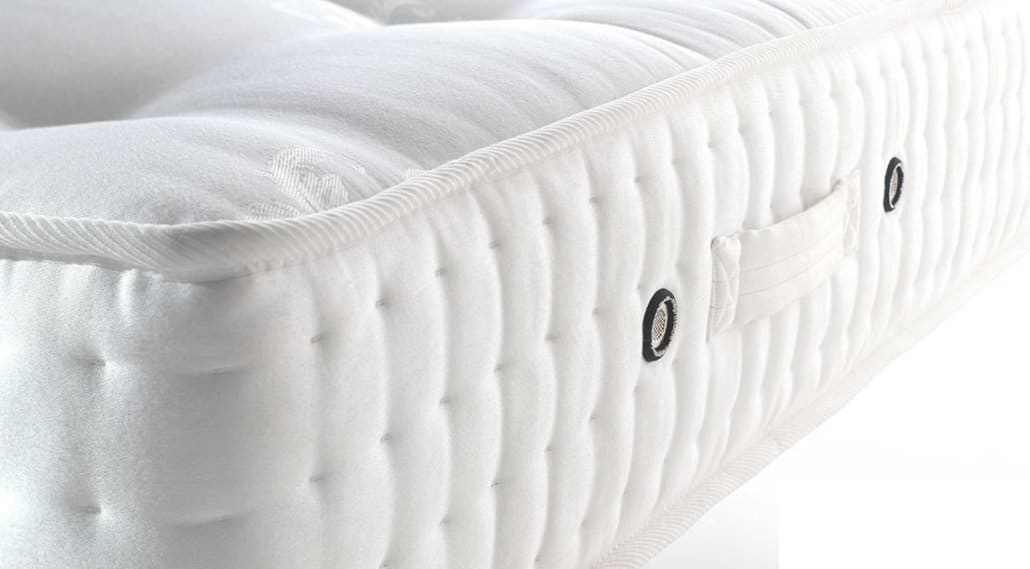Your shopping cart is empty.
Browse our collection or make an appointment.

What is the best pocket spring mattress? And why choose a pocket spring mattress in the first place? With our knowledge, we can give a good answer to that. We have seen all the "kitchens" of the better international mattress factories and heard many user experiences.
A pocket spring mattress allows customization for your body like no other type of mattress, through the creation of different zones with different spring types. A pocket spring mattress also has very good ventilation, is pleasantly cool and has a long lifespan.
Furthermore: make sure that intermediate layers are not glued but tufted, that the mattress has side stitching, that the best qualities of foam have been used and that preferably only natural materials have been used in the mattress. There are big differences in quality and those who want one of the better pocket spring mattresses do not come cheap. Foam mattresses require considerably less euros, but they also cannot match the strengths of a good pocket spring mattress.
Lastly, every person is different and so is every mattress solution. Regardless of the conclusions in the blog: always choose the mattress that suits you best! A good pocket spring mattress starts at 750 euros and goes up to about 3,500 euros per person.
A good pocket spring mattress is extremely comfortable and can be tailored to the body with different pressure zones. Another big advantage is the good ventilation within the mattress. The importance of this becomes clear when you realize that we release half a liter of perspiration to the mattress every night and bacteria thrive especially in warm and moist places. The strengths of a pocket spring mattress can be traced back to its technical construction. But beware: there are also inferior pocket spring mattresses. In this blog, I would like to tell you what to look out for.


The core of a pocket spring mattress consists of metal pocket springs, which in a good mattress are made of hardened steel that maintains shape and resilience for years. Also important is the geometry of the springs and the number of springs. You often read: the more springs, the better, but that is far too general. Customization determines where a higher spring density is desired, for example in the hip zone. All springs are packed in a pouch (pocket) and preferably bound together with natural yarn, in a way that each spring can move completely freely and independently. Reputable manufacturers give many choices of springs, from light to heavy resistance. This allows a pocket spring mattress to be completely customized, for example with a somewhat reinforced hip and shoulder zone. Most mattresses we recommend come out at four different firmnesses (zones).
Of course, you cannot lie directly on the springs and a foam top layer is applied. As Bröring, we are one of the few to work exclusively with 100% natural Talalay latex, the best natural latex on the market. Extremely elastic, ventilates very well, is durable and contains no unhealthy substances for people and the environment. Layers that distribute body pressure are also applied on and under the pocket springs. The better mattresses also use natural materials for this, such as jute or horsehair. Both durable and well ventilated. In the more expensive mattresses we also find refined fillings, such as Shetland wool, cashmere, silk, flax, hemp fiber, bamboo and cotton.
How do you apply said layers without affecting the independent action of the pocket springs? The cheapest solution is gluing, which is where it goes wrong. Those layers glued to the springs directly affect the point elasticity of the springs. The springs can no longer move independently because the plate to which they are glued hardly bends at all. This means less spring comfort and more likely potholes in the mattress. The breathability of the mattress is also limited with these suffocating glue layers. The great advantage of the air movement created in a pocket by springing in and out is lost. And ventilation is precisely such an important benefit. In short: glue breaks more than you care to! Not to mention the chemicals in glue that are unhealthy for people and the environment. Unfortunately, more than three-quarters of all popular pocket spring mattresses are glued, including brands such as Swiss Sense , M Line, Auping and Tempur. Be sure to pay attention to this when purchasing a pocket spring mattress!
So how do you get a breathable and stable construction of the mattress? The answer is tufting, or in better Dutch: studding: many vertical connections are made between the top and bottom of a mattress, with wire or even better with straps. The springs then keep their free action, and all layers and springs of the mattress are nevertheless fixed. Everything stays in place, so to speak. The disadvantage? It makes the mattress slightly more expensive because it is handmade. But if you realize that you spend a quarter of your life lying on your bed, you really do well to choose this. We would be happy to let you feel the difference in comfort in our showroom.
Popular pocket spring mattresses often have somewhat wider "empty" edges that are padded with foam. The downside is that these edges provide no support (you roll off quickly) and don't look tight after a few years. Fortunately, there is a solution: side stitching. The edges of the mattress are then attached internally to the pocket springs. Again, this makes the mattress slightly more expensive, as it is again a manual process. But in the end it is the better choice , because the mattress is more stable and lasts longer. With true top mattresses, the edges are much narrower and the mattress is sprung from edge to edge. These mattresses also have side stitching.



With a pocket spring mattress, also pay attention to the underbed. A box spring is best because it provides good support. But a slatted base is also possible, provided the slats are not too far apart. Each pocket spring must, of course, be supported on the underside. Most pocket spring mattresses can also be placed on an adjustable bed.
Finally, the outer cover, the ticking, also affects sleeping comfort. Most importantly, a ticking should "breathe" very well and thus support the ventilation of the mattress.